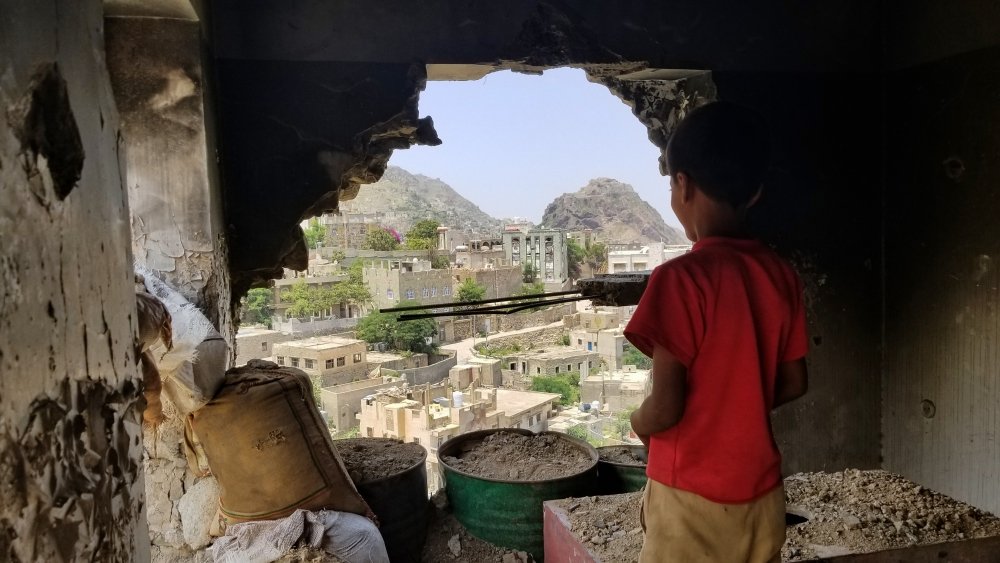Biden’s Peacemaking Bid in Yemen Faces Hard Truths

Shutterstock.com
On March 26, 2015, Saudi Arabia led a coalition of nine Arab states in an invasion of Yemen to crush an Iran-backed rebellion by Shiite Houthis who had seized control of the capital, Sanna’a and were rapidly marching south to take over the entire country.
The Saudis quickly won the backing of the United Nations Security Council that unanimously passed Resolution 2216 (with Russia abstaining) calling upon the Houthi rebels to withdraw their forces from all areas they had just occupied, including Sana’a. The resolution further demanded them to return heavy weapons and missiles pilfered from the military, recognize the authority of the U.N.-recognized Yemeni government, and end their threats to neighboring states. It also reaffirmed the unity and territorial integrity of Yemen.
In addition, the civil war has produced the world’s worst humanitarian disaster, with half the country’s 30 million people facing famine and economic freefall.
After six years of fighting, not even one of these demands has been met by the Houthis. Their Iran-supplied, ever longer-range missiles and drones have become a constant threat to Saudi cities and oil facilities. The country has become de facto divided into old North and South Yemen that existed from their independence from British rule in 1967 until they united in 1990. In addition, the civil war has produced the world’s worst humanitarian disaster, with half the country’s 30 million people facing famine and economic freefall.
The Yemen quagmire has proven an unmitigated disaster for Saudi Arabia and its ambitious Crown Prince Mohammed bin Salman (MBS) who, at the time, had just become the minister of defense and was thus in charge of the invasion. All Saudi coalition partners have withdrawn their military support for the venture. His closest Arab ally, the United Arab Emirates, has switched from backing Yemeni unity to underwriting a secessionist movement in the old South Yemen. The United States, the kingdom’s most important foreign partner, has cut off all military support for its Yemen operations. Iran, Saudi Arabia’s archrival for regional primacy, has skillfully used the Houthis to gain a solid foothold in Yemen from which to threaten the kingdom on a long-term basis. Meanwhile, the internationally recognized government of President Abdu-Rabbu Mansour Hadi, which depends on Saudi Arabia for survival, hardly functions.
Old lines redrawn
The biggest battle of the civil war is now underway between Houthi rebels and government loyalists over the city of Marib in north-central Yemen, 75 miles east of Sana’a. It is the last toehold of the Hadi government in the Houthi-dominated north. It is an oil and gas center with a refinery and a 270-mile-long pipeline reaching the Red Sea for export, offering the Houthis their main source of hard currency income. The outcome of the battle will likely determine whether Yemen is legally and physically re-divided into two countries.
In any case, the Houthis have now consolidated their control over the North where 80 percent of Yemen’s population lives, while rule of the South is shared by a Saudi-forged coalition between the Hadi government and the secessionist movement led by the Southern Transitional Council (STC). The latter’s president, Aidarus al-Zoubaidi, told the British newspaper The Guardian early this month that a referendum “or some other mechanism” must be held to determine “the voice of the South.”
This is the splintered state of Yemen as the Biden Administration opts to take on the role of peacemaker and extricate Saudi Arabia from its “forever war” in the making, just as Biden seeks to disengage the United States from its own such engagement in Afghanistan. Ironically, if Biden’s mission were miraculously to succeed, the outcome might well be the same: U.S.-backed governments in both countries stand a good chance of collapsing, with the Houthis remaining in control of an independent North Yemen and the Taliban of most of Afghanistan.
To make that possible, Biden first had to remove the Houthis from the U.S. list of foreign terrorist organizations where the former Trump Administration had put them just days before leaving office.
Biden has named a special envoy, Timothy Lenderking, a seasoned diplomat well versed in the complexities of Yemen, to seek a peace settlement and open a Saudi exit. He has already made his first trip there to talk to all sides, including a meeting with the Houthi’s chief negotiator, Mohammed Abdulsalam, in Oman in late February. To make that possible, Biden first had to remove the Houthis from the U.S. list of foreign terrorist organizations where the former Trump Administration had put them just days before leaving office.
To have any chance for ending the Yemeni civil war, Biden will have to abandon the demands adopted at the start of the war under pro-Saudi Resolution 2216 and probably also give up the United Nations’ “strong commitment to the unity, sovereignty, independence and territorial integrity of Yemen.” The Saudis seem to have already realized this. They still refer officially to Resolution 2216 as the basis for a peace agreement but have shifted their focus to securing a demilitarized zone along their 800-mile border with Yemen and an end to the Houthi barrage of missiles and drones.
Facing the reality of two Yemens
What price the Saudis will have to pay to obtain even these limited goals remains to be seen. They will need to decide whether to abandon the Hadi government’s claim to represent all of Yemen and will probably have to accept a re-divided country.
Their losses will likely not stop there. The Hadi-STC coalition government that the Saudis brokered late last year hardly exists even in the South. The partners’ separate military forces have already clashed repeatedly, even in Aden, its “temporary” capital. According to the STC’s chief representative in the United States, Abdulsalam Mused, the government has not paid its soldiers for the past nine months or been able to keep the lights on in Aden.
They would probably have to abandon the tens of thousands of tribesmen they have mobilized, financed, and armed to fight the Houthis or face another intra-Yemeni civil war, this time between pro-Hadi and pro-STC tribal militias.
The Saudi dilemma also includes whether to continue supporting the largely fictitious Hadi government or accept the secessionist-minded STC as the new rulers of a reconstituted South Yemen. According to Mused, the Saudis have not made up their minds yet on the issue. They would probably have to abandon the tens of thousands of tribesmen they have mobilized, financed, and armed to fight the Houthis or face another intra-Yemeni civil war, this time between pro-Hadi and pro-STC tribal militias.
A good number of pro-Hadi tribesmen are presently engaged in the defense of Marib city and the larger governorate by the same name. The Houthis launched yet another offensive there in February. According to Mused, they now control partly or completely ten of the governorate’s 14 districts but are still seven to ten miles outside the city itself which is now crammed with a million war refugees.
Officials in the Biden administration have been pressing the Houthis to accept a cease-fire and come to the negotiating table. They “have to demonstrate their willingness to engage in a political process," said State Department spokesman Ned Price. “They need to quit simply stop attacking and start negotiating.” The Houthis have given their answer: no negotiations until the Saudis first end their blockade without conditions of Houthi-controlled ports and airports first. They gave the same reply to a Saudi peace proposal made public Monday offering to lift it but not unconditionally.
At this point, no serious negotiations seem in the offing until the Houthis succeed or fail in capturing Marib city. If they fail, the chances for a cease-fire followed by a compromise solution become somewhat brighter—one based on a federation or confederation holding the North and South loosely together. If they succeed, however, Biden faces the prospect of overseeing the rebirth of two separate Yemens.
The views expressed in these articles are those of the authors and do not reflect an official position of the Wilson Center.
This article was updated at 9:45am on March 24, 2021.
About the Author


Middle East Program
The Wilson Center’s Middle East Program serves as a crucial resource for the policymaking community and beyond, providing analyses and research that helps inform US foreign policymaking, stimulates public debate, and expands knowledge about issues in the wider Middle East and North Africa (MENA) region. Read more












